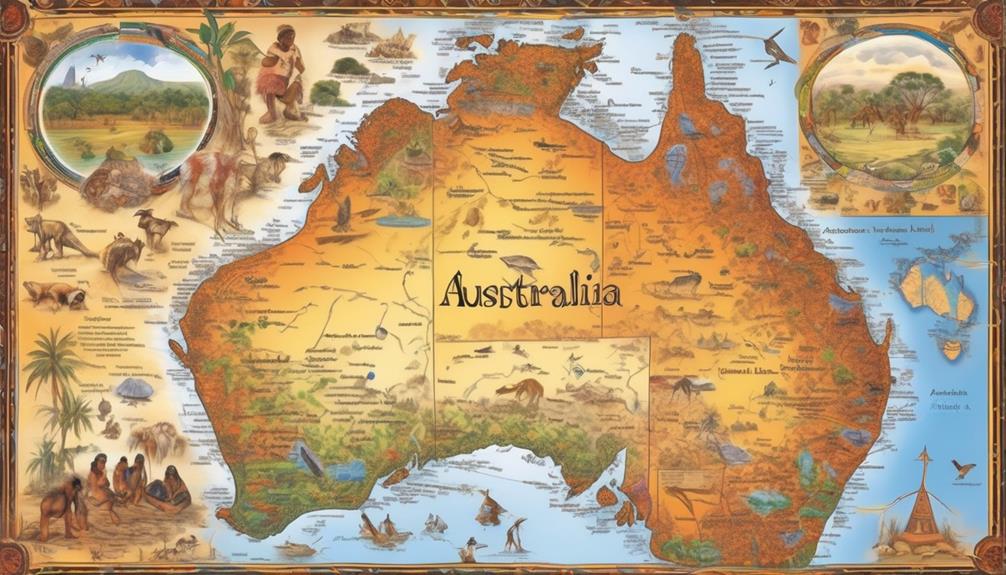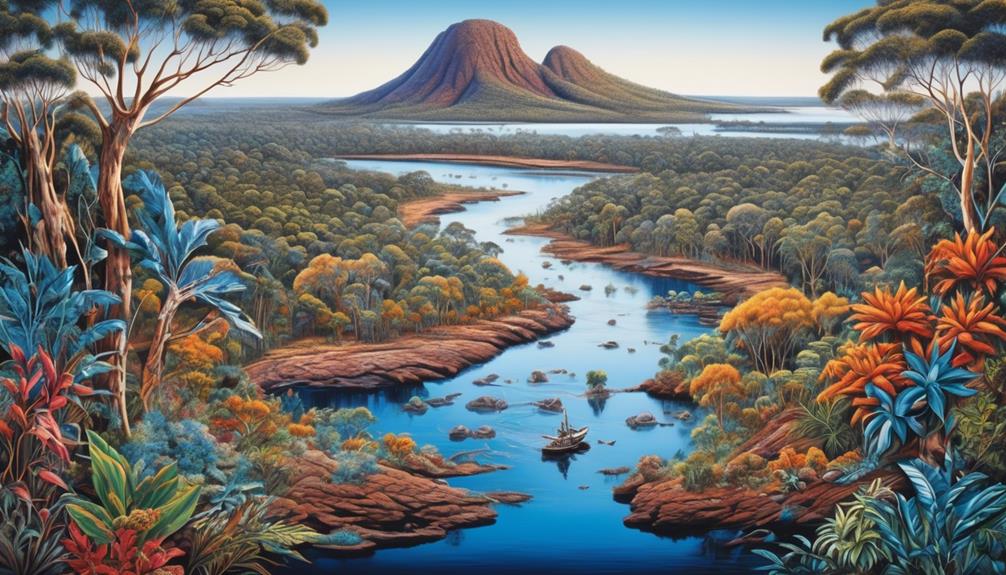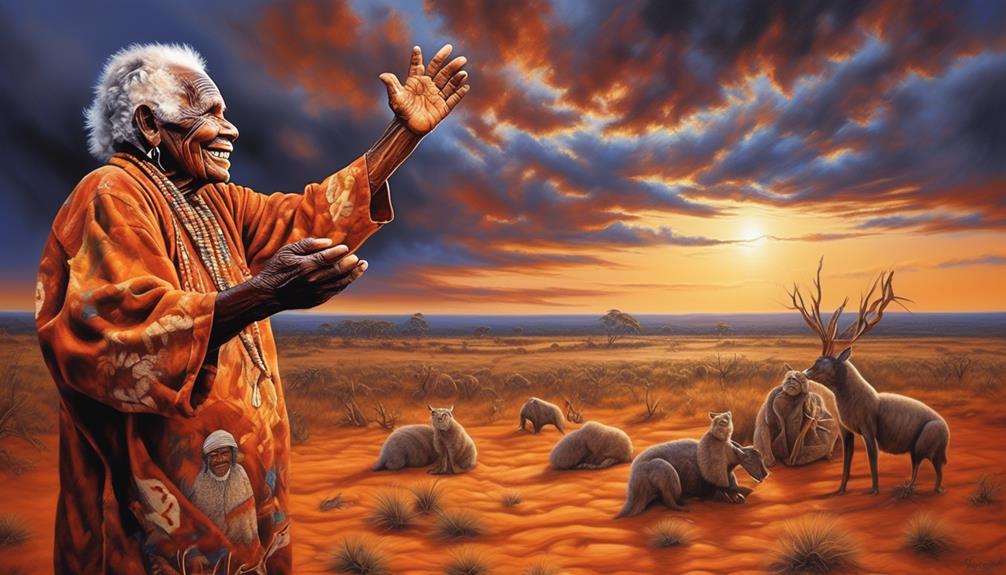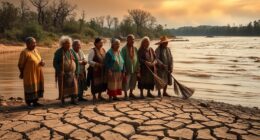The saying “home is where the heart is” truly captures the spirit of Aboriginal Australian communities. They have created their homes in various environments and locations all over the continent. Whether it be bustling city neighborhoods, remote outback dwellings, coastal communities, or traditional villages in the heart of Australia, the Aboriginal people have distinctively made their mark in various parts of the country.
But have you ever wondered about the factors that influence their choice of living spaces and the cultural significance attached to these locations? Let's explore the rich tapestry of Aboriginal residences in Australia and uncover the stories that lie within.
Key Takeaways
- Aboriginal people are increasingly migrating from rural to urban areas in Australia.
- Urban Aboriginal communities face challenges in employment, including discrimination and limited job opportunities.
- Efforts are being made to address employment barriers through targeted programs and partnerships.
- Urban Aboriginal communities also focus on preserving their culture and heritage through community-led initiatives and cultural centers.
Urban Aboriginal Communities
In recent decades, urban Aboriginal communities have become increasingly prominent in Australia, reflecting the migration of Aboriginal people from rural and remote areas to urban centers. This shift has led to a range of challenges and opportunities, particularly in the areas of urban Aboriginal employment, cultural preservation, education, and social services.
Urban Aboriginal employment faces significant barriers, including discrimination, lack of access to education and training, and limited job opportunities. However, there are increasing efforts to address these challenges through targeted employment programs, partnerships with businesses, and initiatives aimed at building economic capacity within urban Aboriginal communities.
Cultural preservation is a critical concern for urban Aboriginal communities, as the pressures of urbanization can erode traditional practices and connections to land. Efforts to preserve culture and heritage are being undertaken through community-led initiatives, support for cultural events and festivals, and the establishment of cultural centers in urban areas.
In terms of education, urban Aboriginal communities face disparities in access to quality education, leading to higher rates of school disengagement and lower educational attainment. Efforts to address these disparities include targeted support programs, culturally sensitive curriculum development, and partnerships between schools and Aboriginal community organizations.
Social services in urban Aboriginal communities are essential for addressing the complex social and health needs of the population. Initiatives such as culturally appropriate healthcare services, housing support programs, and community development projects play a crucial role in supporting the well-being of urban Aboriginal people.
The challenges and opportunities facing urban Aboriginal communities are complex and multifaceted, requiring a comprehensive and culturally sensitive approach to address the needs of this growing population.
Remote Outback Residences
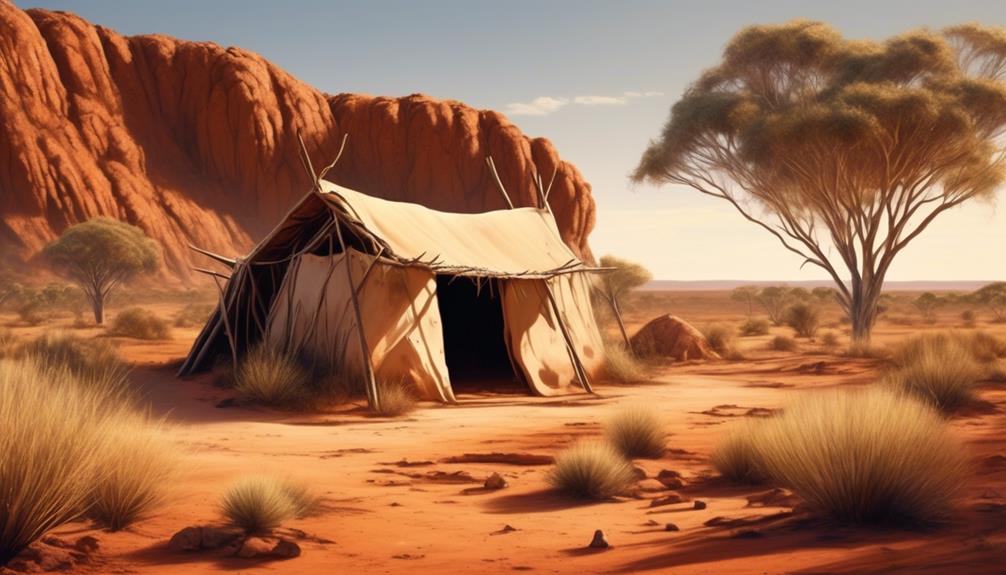
Nestled within the vast and rugged Australian Outback, remote Aboriginal residences are emblematic of a rich cultural heritage intertwined with the land. These communities have unique dynamics that shape their way of life, presenting both challenges and opportunities.
- Remote Outback Employment Opportunities:
Employment in remote Aboriginal residences often revolves around land management, tourism, and art. These communities have a deep connection to the land, which provides opportunities for cultural tourism and sustainable development. Traditional skills such as hunting, gathering, and land conservation also offer employment prospects.
- Cultural Preservation:
Remote Outback residences play a crucial role in preserving Aboriginal cultures and traditions. The isolation of these communities has helped maintain traditional practices, languages, and knowledge of the land. Elders are revered for passing down oral histories and cultural practices to younger generations, ensuring the continuity of Aboriginal heritage.
- Infrastructure Development:
The development of infrastructure in remote Aboriginal residences is essential for improving living standards. Access to clean water, electricity, and reliable transportation is crucial for these communities. Adequate housing and community facilities are also vital for supporting the well-being of residents.
- Healthcare Access:
Access to healthcare services remains a challenge in many remote Outback residences. Limited healthcare facilities and the vast distances to urban centers make it difficult for residents to access medical care. This underscores the need for innovative solutions to ensure the health and well-being of these communities.
Understanding the complexities of remote Aboriginal residences is essential in addressing the unique needs of these communities and fostering sustainable development.
Coastal Aboriginal Settlements
Amid the diverse landscapes of Australia, the rich cultural heritage and unique dynamics of remote Aboriginal residences pivot to the coastal Aboriginal settlements, where the interplay of culture and environment continues to shape the lives of indigenous communities.
Coastal Aboriginal settlements are characterized by their deep connection to the ocean and the traditional practices of coastal aboriginal fishing. For centuries, indigenous communities have relied on the rich marine resources for sustenance and cultural practices. The coastal environment not only provides food but also serves as a significant cultural and spiritual space for indigenous communities, shaping their identity and way of life.
Traditional coastal dwellings, such as the 'gunyah' in the south-eastern regions and 'wurlies' in the northern parts, have been integral to the lives of coastal Aboriginal communities. These dwellings were traditionally constructed using locally sourced materials, blending seamlessly with the coastal landscape. The design of these dwellings often incorporated natural ventilation and protection from the elements, showcasing the deep understanding and adaptation to the coastal environment.
The significance of coastal Aboriginal settlements extends beyond just physical dwellings and fishing practices; it encompasses a profound connection to the land and sea, with stories and traditions deeply rooted in these coastal areas. Understanding and appreciating the cultural significance of these settlements is vital in recognizing the enduring presence and resilience of Aboriginal communities in Australia's coastal regions.
Indigenous Communities in Regional Areas

Indigenous communities in regional areas maintain a distinct cultural identity and continue to uphold traditional practices that are intricately linked to their ancestral lands. These communities face unique challenges and opportunities that shape their way of life and their future. Here are some key aspects to consider:
- Indigenous Employment Opportunities: In regional areas, employment opportunities for Indigenous people are often limited. However, there's a growing emphasis on creating sustainable jobs within the community, such as in land management, tourism, and cultural education programs. This not only provides economic stability but also strengthens the connection to traditional practices.
- Cultural Preservation: Indigenous communities in regional areas place significant importance on preserving their cultural heritage. Initiatives focused on language revitalization, traditional art forms, and storytelling are vital in maintaining and passing on their rich traditions to younger generations.
- Healthcare Access: Access to healthcare services in remote regional areas remains a challenge for Indigenous communities. Efforts to improve healthcare infrastructure and provide culturally sensitive care are ongoing, aiming to address the disparities in health outcomes.
- Education Initiatives: Education plays a crucial role in empowering Indigenous youth and preserving cultural knowledge. Programs that integrate traditional teachings with formal education have been implemented to ensure that Indigenous children have access to quality education while retaining their cultural identity.
Understanding the complexities of Indigenous communities in regional areas is essential in creating meaningful and sustainable support systems that respect their cultural values and contribute to their overall well-being.
Aboriginal People in Rural Towns
As we explore the topic of Aboriginal people in rural towns, it's essential to recognize the unique characteristics and challenges that these communities face.
From the remoteness of their locations to the limited access to essential services, rural Aboriginal communities navigate a distinct set of obstacles.
Additionally, the profound connection to the land and the preservation of cultural practices are central aspects of their identity and daily lives.
Rural Aboriginal Communities
Rural Aboriginal communities in Australia are often characterized by close-knit social structures and a deep connection to the land. When examining these communities, it's essential to recognize the challenges they face in accessing economic opportunities and healthcare services. Here are some key aspects to consider:
- Limited Employment Options: Many rural Aboriginal communities struggle with limited job prospects, leading to higher unemployment rates compared to non-Indigenous populations.
- Healthcare Disparities: Access to healthcare services in these areas is often hindered by factors such as geographical remoteness, cultural barriers, and inadequate infrastructure.
- Cultural Preservation: Despite these challenges, these communities are dedicated to preserving their cultural heritage and traditions, which play a vital role in their identity and well-being.
- Community Resilience: Despite the obstacles, rural Aboriginal communities demonstrate remarkable resilience and resourcefulness in navigating these complex circumstances.
Challenges in Rural Areas
With limited access to economic opportunities and healthcare services, rural Aboriginal communities in Australia face significant challenges that impact their well-being and cultural preservation.
Challenges in rural areas encompass various aspects, including inadequate rural housing conditions, limited access to Indigenous support services, and complexities surrounding land ownership.
Rural housing conditions often suffer from overcrowding, inadequate infrastructure, and lack of maintenance, which directly affects the health and well-being of the community.
Access to Indigenous support services such as culturally appropriate healthcare, education, and employment assistance is limited in rural areas, contributing to the exacerbation of social and economic challenges.
Furthermore, land ownership issues, stemming from historical dispossession and complex legal frameworks, present significant barriers to economic development and cultural sustainability for Aboriginal communities in rural Australia.
Addressing these challenges requires a holistic approach that acknowledges the intersection of social, economic, and cultural factors impacting rural Aboriginal communities.
Connection to the Land
In rural towns across Australia, the deep and enduring connection of Aboriginal people to the land is integral to their cultural identity and spiritual well-being. This connection is rooted in a profound understanding of the land as a source of sustenance, spirituality, and identity. Here are four key aspects that highlight the significance of this connection:
- Land rights and cultural preservation: Aboriginal communities in rural towns actively seek to maintain their traditional connections to the land through land rights initiatives and cultural preservation efforts.
- Environmental stewardship: Aboriginal people in rural areas often play a crucial role in environmental stewardship, drawing on their deep understanding of the land to promote sustainable practices and protect natural resources.
- Sacred sites: The land holds numerous sacred sites that are of immense cultural and spiritual significance to Aboriginal communities, fostering a deep sense of connection and reverence for these places.
- Cultural knowledge transmission: In rural towns, the land serves as a classroom for passing down traditional knowledge, stories, and customs, ensuring the continuity of Aboriginal culture and heritage.
Traditional Indigenous Homelands
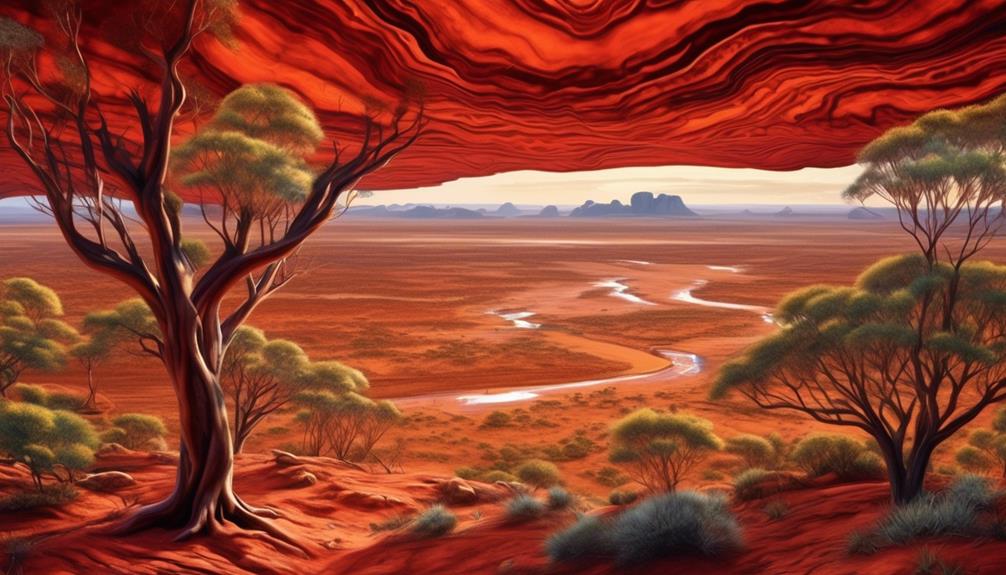
The traditional Indigenous homelands of Aboriginal people in Australia hold profound cultural and spiritual significance, representing the deep connection to the land that has been maintained for thousands of years. These homelands are crucial for Indigenous cultural preservation and have been at the forefront of land rights activism. They are the foundation of Aboriginal identity, spirituality, and social structure. Here is a table summarizing the significance of traditional Indigenous homelands:
| Significance of Traditional Indigenous Homelands |
|---|
| Maintains cultural and spiritual connection to the land |
| Sustains traditional knowledge and practices |
| Fosters social cohesion and community strength |
Traditional Indigenous homelands are vital for the continuation of Aboriginal culture and are intrinsic to the well-being of Indigenous communities. They provide a space where cultural practices, languages, and kinship systems are upheld, ensuring that the rich tapestry of Indigenous heritage endures. These homelands also play a fundamental role in maintaining biodiversity, as Aboriginal people have been the custodians of the land for millennia, possessing a deep understanding of sustainable environmental management.
The significance of traditional Indigenous homelands cannot be overstated. They are the living embodiment of Aboriginal culture and represent the resilience and strength of Indigenous communities in preserving their heritage despite historical and ongoing challenges.
Aboriginal Reservations and Missions

Exploring the historical significance and contemporary implications of Aboriginal reservations and missions provides valuable insight into the complex and often challenging experiences of Indigenous communities in Australia. These areas have played a pivotal role in shaping the social, cultural, and economic landscapes for Aboriginal peoples.
Here's an in-depth look at the current situation regarding Aboriginal reservations and missions:
- Land Rights: Aboriginal reservations and missions are closely linked to the ongoing struggle for land rights. Many of these areas were established on traditional Indigenous lands without consent, leading to displacement and loss of cultural connection. Today, there are ongoing efforts to address these historical injustices through land rights claims and negotiations.
- Cultural Preservation: Despite the difficult history associated with reservations and missions, many Aboriginal communities continue to reside in these areas, striving to preserve their cultural heritage and traditions. They've been working tirelessly to reclaim and revitalize their languages, ceremonies, and traditional practices, asserting their right to maintain their cultural identity.
- Contemporary Challenges: The legacy of reservations and missions has left a lasting impact on Indigenous communities, contributing to issues such as socio-economic disadvantage, health disparities, and intergenerational trauma. These challenges persist and require comprehensive, culturally sensitive approaches to address them effectively.
- Empowerment and Advocacy: Within these communities, there's a growing movement focused on empowerment and advocacy. Aboriginal leaders are actively engaging in efforts to address the systemic issues affecting their communities, advocating for greater recognition of their rights and autonomy.
Understanding the current dynamics of Aboriginal reservations and missions is essential in addressing the complexities surrounding Aboriginal land rights and cultural preservation.
Aboriginal Housing in Cities
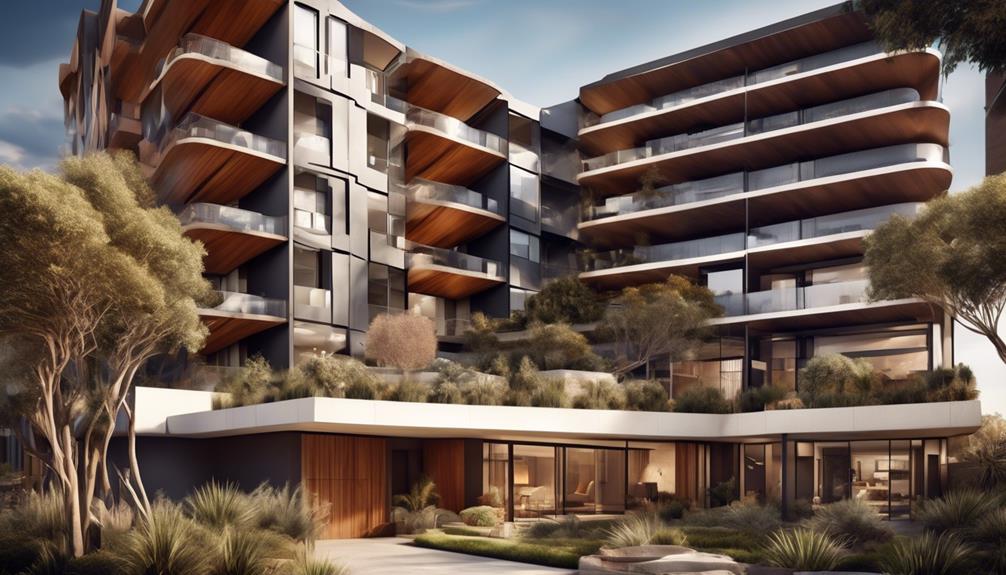
Having examined the historical significance and contemporary implications of Aboriginal reservations and missions, our focus now shifts to the challenges and opportunities surrounding Aboriginal housing in urban areas of Australia.
The housing challenges faced by urban Aboriginal communities are complex and multifaceted. High levels of overcrowding, inadequate infrastructure, and socioeconomic disparities contribute to the difficulties in accessing safe and affordable housing. Additionally, historical injustices, discrimination, and cultural insensitivity have further compounded the housing challenges for urban Aboriginal populations.
Urban Aboriginal support services play a crucial role in addressing these housing challenges. These services encompass a wide range of initiatives, including culturally sensitive housing assistance programs, advocacy for housing rights, and community development projects. Organizations and agencies that provide support to urban Aboriginal populations work tirelessly to bridge the housing gap by offering tailored solutions that respect and incorporate Aboriginal cultural values and practices.
Furthermore, the design and implementation of housing initiatives for urban Aboriginal communities must be approached with cultural knowledge and sensitivity. Recognizing the diverse needs and aspirations of urban Aboriginal people is paramount in developing effective housing strategies. Collaborative efforts involving community members, policymakers, and housing experts are essential in creating sustainable and culturally appropriate housing solutions for urban Aboriginal populations.
Indigenous Peoples in Northern Territories

In the Northern Territories of Australia, the Indigenous peoples have a rich cultural heritage that's deeply intertwined with the land and its natural resources. Our exploration of the Indigenous Peoples in the Northern Territories reveals a profound connection to the land, a diverse cultural tapestry, and a resilient history shaped by both traditional and contemporary influences.
- Traditional Connection to the Land: Indigenous cultures in the Northern Territories have a profound spiritual and cultural connection to the land. The land isn't just a physical space but a living entity, imbued with stories, traditions, and spiritual significance that have been passed down through generations.
- Cultural Diversity: The Indigenous peoples of the Northern Territories encompass diverse cultural groups, each with its unique traditions, languages, and customs. From the Arrernte people of Central Australia to the Yolngu people of Arnhem Land, the region is a mosaic of rich and varied Indigenous cultures.
- Historical Resilience: The history of the Northern Territories is marked by resilience in the face of colonization, displacement, and cultural adversity. Despite the challenges, Indigenous communities have preserved and celebrated their cultural heritage, fostering a strong sense of identity and belonging.
- Contemporary Challenges and Triumphs: Today, Indigenous communities in the Northern Territories continue to navigate the complexities of modern society while safeguarding their cultural traditions. From initiatives in education and economic development to cultural revitalization efforts, Indigenous peoples are actively shaping the future while honoring their past.
Our examination of Indigenous Peoples in the Northern Territories underscores the enduring legacy of Indigenous cultures and the significance of the region's history in shaping contemporary realities.
Aboriginal Villages in Central Australia

We found that Central Australia is home to remote desert communities where Aboriginal people have lived for thousands of years. These villages are deeply connected to traditional land ownership, providing a strong sense of cultural identity and belonging.
Understanding the significance of these communities is crucial in appreciating the rich cultural heritage of Aboriginal people in Central Australia.
Remote Desert Communities
Nestled within the expansive red sands of Central Australia, remote desert communities are home to Aboriginal villages that have sustained rich cultural traditions for centuries. These communities face unique challenges and opportunities due to their remote location and distinct cultural heritage.
- Economic Opportunities: Limited economic opportunities exist in these areas, often leading to high unemployment rates and financial hardships for residents.
- Access to Services: Access to essential services such as healthcare, education, and infrastructure is often limited, posing significant challenges for community members.
- Cultural Preservation: These communities play a vital role in preserving traditional Aboriginal culture, language, and practices, serving as custodians of ancient knowledge and wisdom.
- Environmental Sustainability: Striking a balance between modern development and the preservation of the delicate desert ecosystem is a crucial consideration for these communities.
Navigating the complex interplay of tradition, modernity, and sustainability is essential for the continued prosperity of these remote desert communities.
Traditional Land Ownership
Amidst the vast and ancient landscapes of Central Australia, traditional land ownership holds profound significance for Aboriginal villages, serving as the foundation of their cultural identity and connection to the land. The Aboriginal people of Central Australia have a deep-rooted connection to their traditional lands, which is integral to their spiritual and physical existence. Land rights are crucial for the preservation of Aboriginal culture, as they allow for the continuation of sacred ceremonies, storytelling, and traditional practices that have been passed down through generations. The table below provides a snapshot of some Aboriginal villages in Central Australia and their traditional land ownership.
| Aboriginal Village | Traditional Land Ownership | Land Rights Status |
|---|---|---|
| Uluru-Kata Tjuta | Anangu people | Recognized |
| Hermannsburg | Arrernte people | Recognized |
| Areyonga | Pitjantjatjara people | Recognized |
The traditional land ownership system is vital for the cultural preservation of Aboriginal communities in Central Australia.
Aboriginal Camps and Outstations
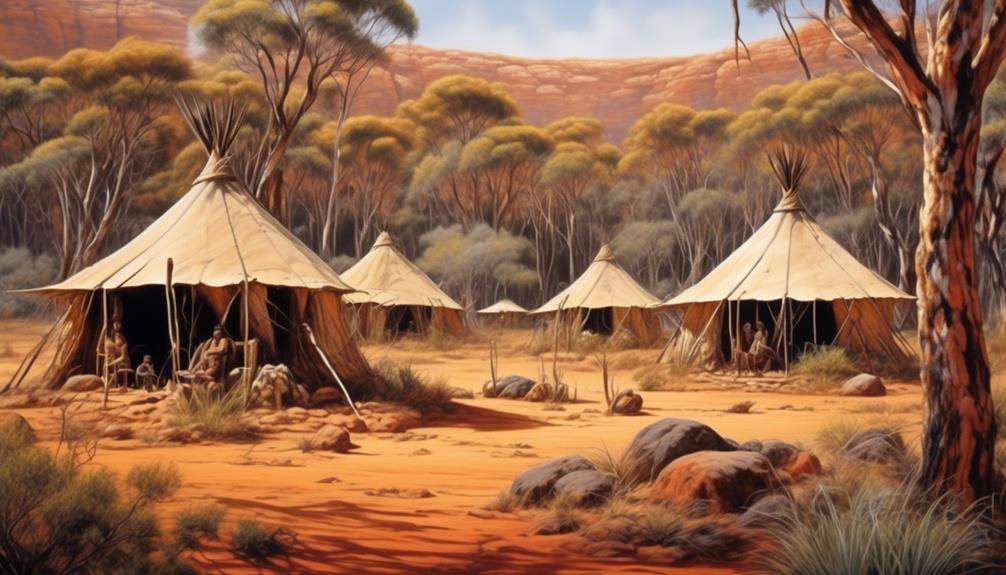
Aboriginal camps and outstations play a crucial role in the traditional lifestyle and cultural practices of Aboriginal people in Australia. These living spaces hold deep cultural significance, serving as hubs for passing down oral traditions, practicing traditional ceremonies, and fostering a strong connection to the land.
Here are four key aspects of Aboriginal outstation living and the challenges faced in maintaining Aboriginal camps and developing infrastructure:
- Traditional Living Practices: Outstations are often located in remote areas, allowing Aboriginal people to maintain a close connection to their ancestral lands. These spaces provide a sense of belonging and cultural identity, enabling the continuation of traditional hunting, gathering, and land management practices.
- Community Cohesion: Outstations are vital for fostering community cohesion and preserving Aboriginal languages and cultural knowledge. They serve as spaces where elders pass down knowledge to the younger generations, ensuring the continuity of cultural practices and customs.
- Challenges in Infrastructure Development: Many Aboriginal camps and outstations face challenges in accessing essential infrastructure such as clean water, healthcare services, and educational facilities. The remote locations of these living spaces often make it difficult to implement necessary infrastructure developments.
- Maintaining Cultural Integrity: The encroachment of modern developments and resource extraction poses a threat to the cultural integrity of Aboriginal camps and outstations. Balancing the need for economic development with the preservation of cultural heritage is an ongoing challenge for Aboriginal communities.
These factors highlight the complex interplay between cultural significance, traditional living practices, and the challenges faced in maintaining Aboriginal camps and outstations.
Indigenous Housing in Western Australia
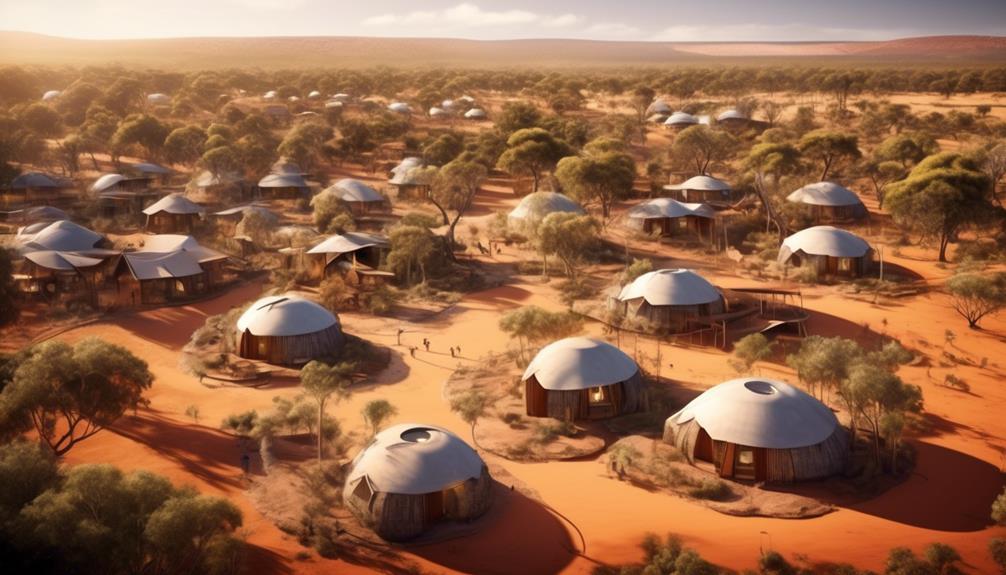
In Western Australia, the housing conditions for Indigenous communities vary widely. Many of these communities face overcrowding, inadequate infrastructure, and a lack of maintenance. These challenges can have serious implications for the health and well-being of Aboriginal people. As a result, there is an urgent need for improved housing solutions that address these issues.
Community support and engagement play a crucial role in addressing the housing challenges faced by Indigenous communities in Western Australia. By involving the community in decision-making processes and actively seeking their input, culturally appropriate housing initiatives can be developed. These initiatives have the potential to positively impact the lives of Indigenous Australians by providing them with safe and suitable housing options.
Housing Conditions
The housing conditions for Indigenous communities in Western Australia reflect a complex interplay of historical, social, and economic factors, which significantly impact the quality of life for Aboriginal people in the region. When considering housing conditions, it's crucial to address the following key points:
- Housing Affordability: Many Indigenous Australians in Western Australia face challenges in accessing affordable housing, leading to overcrowding and inadequate living conditions.
- Access to Infrastructure: Remote Indigenous communities often struggle with limited access to essential infrastructure such as clean water, sanitation, and electricity.
- Maintenance and Repairs: Due to financial constraints, many Indigenous households encounter difficulties in maintaining and repairing their homes, resulting in deteriorating living conditions.
- Cultural Considerations: Traditional housing designs and cultural practices are essential for Indigenous communities, and efforts to improve housing conditions must incorporate these cultural aspects to ensure community well-being.
These factors contribute to the housing disparities experienced by Indigenous communities in Western Australia, highlighting the need for targeted interventions and support.
Community Support
Amid the multifaceted challenges facing Indigenous communities in Western Australia, addressing the critical need for community support is paramount in improving the housing conditions and overall well-being of Aboriginal people in the region. Community programs play a vital role in providing essential services such as housing assistance, healthcare access, and cultural preservation initiatives. These programs are designed to address the specific needs of Aboriginal communities, ensuring that their cultural values and traditions are respected and preserved. By actively involving the community in decision-making processes and providing support tailored to their unique cultural context, these programs contribute to the sustainability of Indigenous housing and the overall well-being of the people. Through collaborative efforts and culturally sensitive approaches, community support initiatives are essential in creating a positive and sustainable living environment for Aboriginal people in Western Australia.
| Community Support Programs | Description | Impact |
|---|---|---|
| Housing Assistance | Provides support for affordable and adequate housing options | Improves living conditions and stability |
| Healthcare Access | Ensures access to healthcare services and resources | Enhances overall well-being and health outcomes |
| Cultural Preservation | Supports the preservation of Indigenous traditions and values | Strengthens community identity and resilience |
Frequently Asked Questions
What Are Some Traditional Indigenous Homelands That Have Been Preserved in Modern Australia?
Preservation of traditional indigenous homelands in modern Australia is vital for cultural sustainability. Many Aboriginal communities have upheld their ancestral connections to the land, despite urban housing challenges.
These homelands serve as centers for cultural practices and knowledge transmission. Areas like Arnhem Land and the Kimberley region are examples of preserved indigenous homelands that showcase the resilience and determination of Aboriginal communities to maintain their cultural identity and connection to the land.
How Has Government Policy Affected the Housing Situation for Aboriginal People in Urban Areas?
Government policy has significantly impacted the urban housing situation for Aboriginal people. Displacement, inadequate infrastructure, and socio-economic disparities have harmed indigenous communities. Policies often neglect cultural considerations, exacerbating the housing crisis.
These issues require a comprehensive and culturally sensitive approach to address the complex historical and systemic challenges faced by Aboriginal people in urban areas.
What Are Some of the Unique Challenges Faced by Aboriginal People Living in Remote Outback Residences?
Challenges faced by Aboriginal people in remote outback residences are multifaceted. Access to essential services, healthcare, and education is limited, and the harsh environment presents unique difficulties.
Maintaining cultural connections to Indigenous homelands is challenging due to distance and lack of resources. Economic opportunities are scarce, contributing to social and wellbeing challenges.
These factors impact the resilience and wellbeing of Aboriginal communities in remote living situations.
How Do Coastal Aboriginal Settlements Differ From Indigenous Communities in Regional Areas?
Coastal Aboriginal settlements differ significantly from indigenous communities in regional areas due to unique housing challenges. In coastal areas, access to resources and infrastructure is often more accessible, leading to different housing designs and community structures.
Conversely, regional settlements face greater remoteness and limited resources, impacting housing availability and quality. Understanding these differences is crucial in addressing the diverse needs of Aboriginal communities and ensuring equitable access to housing solutions.
What Are Some of the Key Issues Surrounding Indigenous Housing in Western Australia?
When it comes to Indigenous housing in Western Australia, the key issues revolve around housing affordability, community development, and government support.
Indigenous communities often face challenges in accessing adequate housing due to factors like remote location and lack of resources.
Government initiatives aimed at improving housing conditions are crucial, but must be culturally sensitive and community-driven.
Addressing these issues requires a comprehensive approach that considers the unique cultural and social dynamics of Indigenous communities.
Conclusion
After conducting in-depth research, we've discovered that Aboriginal people in Australia live in a variety of settings. These settings include urban communities, remote outback residences, coastal settlements, regional areas, rural towns, Northern Territories, central villages, camps, and outstations.
This diverse range of living environments reflects the rich cultural and historical connections of the Aboriginal people to the land and their traditional ways of life.
